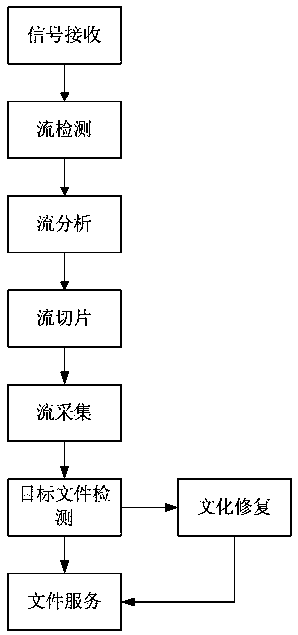A Method of Recording IP Flow Based on Fragmented Files
A file and fragmentation technology, applied to electrical components, color TV parts, TV system parts, etc., can solve the problems of large final files, discontinuous video and audio data, unavailable final recorded files, etc.
- Summary
- Abstract
- Description
- Claims
- Application Information
AI Technical Summary
Problems solved by technology
Method used
Image
Examples
Embodiment 1
[0040] A method for recording IP streams based on fragmented files, the system used in the method includes: a plurality of clients, a plurality of clients connected to a streaming media service end formed by a server cluster through a network, and the streaming media The server is connected to the video information source, such as figure 1 shown.
[0041] Video information source is a general term for various video information output sources, including: video signals from other TV stations transmitted by satellite or cable, video signals received from other TV stations on the ground, video signals on existing tapes, CDs, and video signals on the Internet. The types of these video signals are different, and they can be IP streaming signals, or video signals such as SDI and ASI.
[0042] The receiving layer, stream processing layer and service layer are set in the streaming media server.
[0043] Receive layer:
[0044] The receiver layer receives and processes recorded signa...
Embodiment 2
[0062] This embodiment is an improvement of the first embodiment, and is a refinement of the "step of receiving signals" of the first embodiment. The "signal receiving step" described in this embodiment includes the following sub-steps:
[0063] The sub-step of signal type judgment: it is used to judge whether the received signal is an IP flow signal, if yes, enter the "flow analysis step", if not, enter the next sub-step.
[0064] The sub-step of decoding: it is used to decode according to the signal data type to form the original video and audio signal.
[0065] Encoding sub-step: used to encode the original video and audio signal into an IP stream signal, and then enter the "stream analysis step".
Embodiment 3
[0067] This embodiment is an improvement of the first embodiment, and it is a refinement of the first embodiment about "flow analysis steps". The "steps of stream analysis" described in this embodiment include the following sub-steps:
[0068] Consistency detection sub-step: used to detect whether the PSI information in the TS stream is consistent. If the PSI information changes, it means that the signal of the TS stream has changed at this time, and the video and audio data needs to be segmented here to ensure that the front and rear TS stream data Independent of each other, the files are available.
[0069] The sub-step of continuity detection: it is used to detect the continuity of current TS flow data PCR and DTS / PTS. The stream detection in the first embodiment takes the TS stream as an example. First, check whether the PSI information in the TS stream is consistent. If the PSI information changes, it means that the signal of the TS stream has changed, and the video and ...
PUM
 Login to View More
Login to View More Abstract
Description
Claims
Application Information
 Login to View More
Login to View More - R&D
- Intellectual Property
- Life Sciences
- Materials
- Tech Scout
- Unparalleled Data Quality
- Higher Quality Content
- 60% Fewer Hallucinations
Browse by: Latest US Patents, China's latest patents, Technical Efficacy Thesaurus, Application Domain, Technology Topic, Popular Technical Reports.
© 2025 PatSnap. All rights reserved.Legal|Privacy policy|Modern Slavery Act Transparency Statement|Sitemap|About US| Contact US: help@patsnap.com



